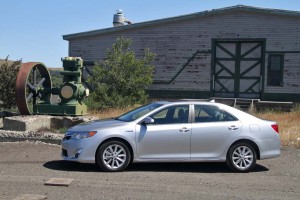As part of a strategy to give the North American market as much autonomy as possible, Toyota will soon cease importing Camry sedans from Japan, relying solely on two U.S. plants to provide more than a third of a million copies of the midsize model annually.
The move roughly coincides with the upcoming launch of the 2012 Toyota Camry. Though it is only one of about 10 new products the maker is launching in the months ahead the remake may be considered both the most important and the most challenging.
The Camry has long dominated the American sales charts, grabbing the top spot among passenger cars for the last 9 years running and 13 of the last 14 years. But in recent months, as Toyota – like many of its Japanese rivals – has struggled with product shortages triggered by that country’s devastating March earthquake and tsunami – the Camry has fallen behind the Chevrolet Cruze and will have a battle ahead to hold onto its crown for all of 2011.
The shift to a fully U.S. production base comes as Toyota’s North American operations gain increasing autonomy. But the move also reflects the devastating impact of the strong yen, which has slashed Toyota’s profit margins.
Going forward, the North American version of the Camry will be built exclusively at the maker’s Georgetown, Kentucky factory and at the Subaru plant in Indiana that has shared some of its excess capacity with Toyota in recent years. (The larger maker holds a small ownership stake in Subaru parent Fuji Heavy Industries.) The decision comes 25 years after Toyota broke ground for the Georgetown plant, the first it set up on its own in North America.
“We have the capacity here and we’re committed to building vehicles where they are sold. Going forward, 100 percent of the Camrys we sell in the U.S. will be built here. The very small number of imported Camrys were a buffer supply,” a Toyota spokesperson told TheDetroitBureau.com in an e-mail.
While Toyota has been coy about hard numbers, it is expected to try to push sales of the new Camry to at least 360,000 annually, which would not only maintain volume – if notably not generating the sort of sales gains Toyota once expected – but also help it hold onto sales leadership.
“We expect Camry will continue to earn its position as America’s number-one selling passenger car,” said Toyota brand boss Bob Carter, during a Los Angeles news conference last month officially introducing the 2012 Camry.
Speaking from the Georgetown plant, Toyota Motor Co. CEO Akio Toyoda stressed that the Camry “has become a symbol of our success,” underscoring the importance of maintaining its market-leading position. The new model, he suggested, is “an opportunity to show the world again what Toyota is all about.”
But the grandson of Toyota’s founder has also noted that the launch of the new Camry – as well as the upcoming re-launch of the Lexus GS — coincides with significant changes within the global giant. In the wake of Toyota’s quality and safety crisis, during which the maker was forced to recall more than 10 million vehicles between late 2009 and early 2010, the carmaker has decided to expand the autonomy regions like North America have when it comes to key decisions.
How well that works will likely become apparent with the Camry roll-out and with the launch of the GS and other new models – which also include a plug-in version of the Prius hybrid, as well as Toyota’s first all-electric model, the RAV4-EV.
But there’s another, more practical reason for shifting Camry solely to a U.S. factory base. With the dollar nudging as low as 76 yen in recent months it has become increasingly impractical to import vehicles from Japan, especially small and midsize models where margins are nowhere near as great as on a high-line product like the Lexus GS.
Every yen shift adds up to millions of dollars in lost profits, Toyota officials have acknowledged.
Moving to the U.S. doesn’t entirely eliminate the impact of the exchange rate, however. The fact that Toyota’s North American plants were forced to briefly shut down and then operate at significantly reduced rates during late spring and early summer reveal the maker’s continuing dependence upon parts and component imported from Japan.
But Toyota is moving to change its purchasing policies, as well, and is expected to continue boosting its dependence upon American suppliers and Japanese parts makers who shift operations to the States.

